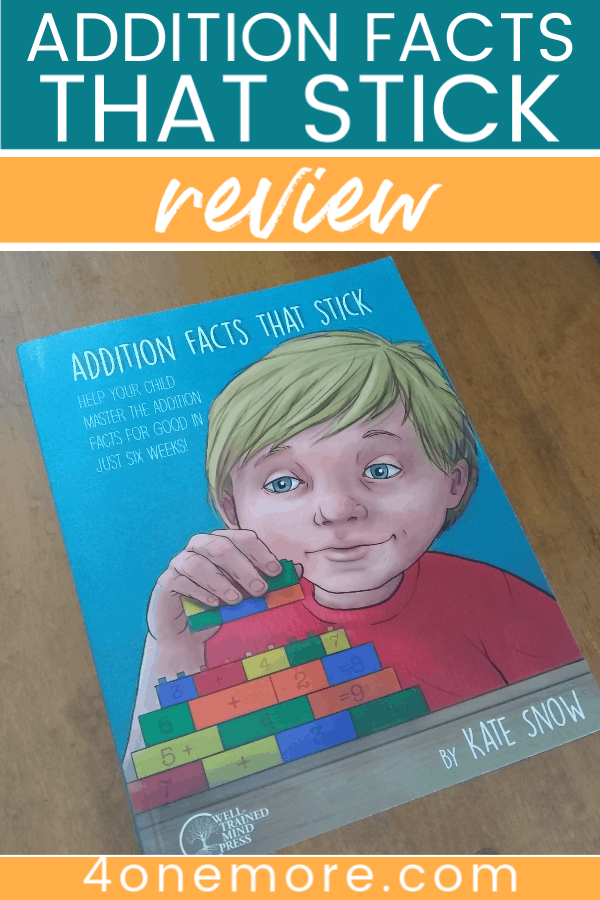Do you have kids that could use some serious review of their math facts? But do you want to approach it in a fun way instead of the normal dry and boring way we all learned our math facts? Then the Math Facts That Stick series will help. Here’s our experience using Addition Facts That Stick.

Disclaimer: I received a copy of this product in exchange for my honest review. I was not required to write a positive review, nor was I compensated in any other way. All opinions I have expressed are my own or those of my family. I am disclosing this in accordance with the FTC Regulations.
This post contains affiliate links for your convenience. I will receive a commission if you purchase from these links. Thank you.
My first grader had covered all the main additional and subtraction fact families with her math curriculum. But, like most kids, she could use some additional practice and repetition to help the facts stick.
Kate Snow, author of the Math Facts That Stick Series, sent us her addition book to try out. And I was pleasantly surprised to see how my daughter begged to play the games in this book.
Here’s a peek inside Addition Facts That Stick.

Methodology of Addition Facts That Stick
This book will take your child through six weeks of addition instruction and game-based learning.
Here is an outline of the book:
- Week 1: Adding one and two
- Week 2: Pairs that make ten
- Week 3: Sums less than ten
- Week 4: Adding nine
- Week 5: Adding eight
- Week 6: Look at the leftovers
The first day of each week includes new teaching, which is scripted out for the parent. Once you’ve taught or reviewed a math concept, then you can introduce the new game for the week.

Days 2-5 are used as review days via playing the game and completing practice pages.
Playing the games allows your child to apply the mental math strategies. Plus the games and activities use common household items, so you likely won’t need to purchase additional resources.

Completing practice pages gives written practice of that week’s facts along with review of facts learned in previous weeks.

There is enough variety in this resource that your child will not get burned out with the addition instruction and review! In fact, it was enjoyable for both my daughter and myself.

This is a very complete addition resource, adding up to 131 pages.
Plus, the author includes answer keys to all the practice pages for easy checking of your child’s written work.
How We Used It
Near the end of her first-grade year, my daughter and I started working through this book for about 15 minutes per day.

We completed Week 1 of Addition Facts That Stick, then went back to her math curriculum for a week. The next week, we focused on Week 2 in Addition Facts That Stick, and so on.
Since her math curriculum uses a spiral approach, we were able to work on addition facts as they came up in the curriculum. Addition Facts That Stick made a nice resource for additional help, practice, and review.
Recommendations
Kate recommends using this resource for only 15 minutes per day, 5 days a week. Used consistently, this will bring long-term mental math strength to your kids.
The author also recommends this resource only for kids who are at least six years old. Here are a few other prerequisites:
- child should be able to count to 20 & recognize written numbers up to 20
- understand the concept of addition (order doesn’t matter)
- have a beginning understand of place-value (10+5 is the same as 15)
Purchase of this book allows you to make copies for your own homeschool. So, instead of tearing the game pages or practice pages out of the book, I copied them. The game pages went into plastic sheet protectors so we can use them over and over.

Copying the practice pages allows my daughter to try to beat her time or her score for a fun regular practice of her addition facts!
After using this resource with my daughter, I would highly recommend it to any family who needs an easy-to-use plan to finally help those addition facts to stick!
Reasons we recommend Addition Facts That Stick:
- inexpensive
- flexible enough to use with any math curriculum
- open & go
- scripted
- easy to use
- includes games
- includes written practice
- can be used for multiple kids in your family
Want to hear more about teaching math in your homeschool? Check out this interview with Kate Snow, the author of Addition Facts That Stick! She was my guest on episode #63 of the Homeschool with Moxie Podcast.